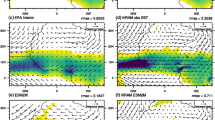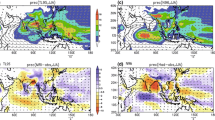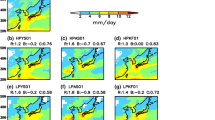Abstract
In this paper, the global and regional features of the seasonal variation of general circulation, and especially the Asian monsoon simulated by the Institute of Atmospheric Physics Two-level AGCM coupled with a sophisticated land-surface model (IAP94-GCM) are presented and compared with the observation. The comparison is made by using the equilibrium multiyear seasonal cycle climate from a 100-year integration. In the integration sea surface temperature (SST) and sea ice are taken from the observed climatological data (with seasonal variation) because our purpose is to see the improvement of simulation due to the coupling with an advanced land surface model.
Overall, the IAP94-GCM provides a reasonably realistic simulation of the interseasonal and intraseasonal climatology of the Asian monsoon and yields an important information that sheds light on the thermal underpinning and the thermodynamics of the seasonal and even multiscale variabilities associated with the Asian summer monsoon.
Similar content being viewed by others
Referneces
Arakawa A., Katayama A., and Y. Mintz (1969), Numerical simulation of the general circulation of the atmosphere, Proceedings of the WMO/IUGG Symposium on Numerical Weather Prediction, Tokyo, Japan Meteor. Agency, pp. IV-7 to IV-8-12.
Barnett T.P., Dumenil L., Schlese U., Roeckner E., and M. Latif (1989), The effect of Eurasian snow cover on regional and global climate variations. J. Atmos. Sci., 46: 661–685.
Cess R.D., (1985), Nuclear war: Illustrative effects of atmospheric smoke and dust upon solar radiation, Climate Change, 7: 237–251.
Cess R.D. and G.L. Potter (1987). Exploratory studies of cloud radiation forcing with a general circulation model, Tellus, 39A: 460–473.
Cess R.D., Potter G.L., Ghan S.J., and W.L. Gates (1985), The climate effects of large injections of atmospheric smoke and dust: A study of climate feedback mechanisms with one- and three-dimensional climate models. J. Geophys. Res., 90: 12937–12950.
Dai Y.J. and Q.C. Zeng (1997). A land surface model (IAP94) for climate studies, Part I: Formulation and validation in off-line experiments. Advances in Atmospheric Sciences, 14: 433–460.
Dai Y.J., F. Xue and Q.C. Zeng (1998), A land surface model (IAP94) for climate studies, Part II: Implementation and preliminary results of coupled model with IAP AGCM, Advances in Atmospheric Sciences, 15: 47–62.
Dorman J.L. and P.J. Sellers (1989). A global climatology of albedo, roughness length and stomatal resistance for atmospheric general circulation models as represented by the simple biospheres model (SiB). J. Appl. Meteor., 28: 833–855.
Douville H. and J.F. Royer (1996), A new snow parameterization for Sensitivity of the Asian summer monsoon to an anomalous Eurasian snow cover within the Meteo-France GCM, Clim. Dym., 12: 449–466.
Gates W.L. and A.B. Nelson (1975). A new tabulation of the Scripps topography on a 1° global grid, Part I: Terrain heights, R-1276-1-ARPA, The Rand Corporation. Santa Monica, CA, 132 pp.
Jaeger L (1976), Monatskarten des Niedeschlag fur die ganze Erde, Berichto des deutschen Wetterdienstes, Nr. 139, pp 38.
Kalnay E., couathors (1996), The NCEP/NCAR 40-year reanalysis project, Bull. Amer. Meteor. Soc., 77: 437–471.
Katayama A (1972), A simplified scheme for computing radiative transfer in the troposphere, Tech Rep No. 6 Department of Meterology, University of California, Los Angeles, CA, 77 pp.
Lau K.-M. and S. Yang (1996), Seasonal variation, abrupt transition, and intraseasonal variability associated with the Asian summer monsoon in the GLA GCM. J. Clim., 9: 965–985.
Li C. and M. Yanai (1996). The onset and interannual variability of the Asian summer monsoon in relation to land-sea thermal contrast, J. Clim., 9: 385–375.
Lin Z.H., Q.C. Zeng and B. Ouyang (1996), Sensitivity of IAP 2L AGCM to surface albedo variation, Theoretical and Applied Climatology (Special Issue), 157–162.
Meehl G.A. (1994), Influence of the land surface in the Asian monsoon: External conditions versus internal feedback. J. Clim., 7: 1033–1049.
Smagorinsky J. (1963), General circulation experiments with the primitive equations, 1: The basic experiment, Mon. Wea. Rev., 93: 99–164.
Vernekar A.D., Zhou, J., and J. Shukla (1995), The effect of Eurasian snow cover on Indian monsoon, J. Clim., 8: 248–266.
Wilson M.F. and A. Henderson-Sellers (1985), A global archive of land cover and soil data for use in general circulation climate models, J. Climatol., 5: 119–143.
Yang, S., Lau K.-M., and M. Sankar-Rao (1996), Precursory signals associated with the internannual variability of the Asian summer monsoon, J. Clim., 9: 949–964.
Yasunari T., Kitoh, A., and T. Tokioka (1991), Local and remote responses to excessive snow mass over Eurasian appearing in the northern spring and summer climate—a study with the MRI GCM, J. Meteor Soc. Japan, 69: 473–487.
Yeh T.C., S.Y. Tao and M.T. Li (1959), The abrupt change of circulation over the Northern Hemisphere during June and October, in the Atmosphere and the Sea in Motion, 249-267.
Zeng Q.C., X.H. Liang and M.H. Zhang (1988), Numerical simulation of the monsoon and the abrupt seasonal change in general atmospheric circulation, Chinese Journ. Atmos. Sci., Special Issue, 22–42. (in Chinese)
Zeng Q.C., Zhang X.H., Liang X.Z., Yuan C.G., and S.F. Chen (1989), Documentation of IAP two-level Atmospheric General Circulation Model, TR044, DOE/ER/60314-HI, 383 pp.
Zeng Q.C., Zhang B.L., Liang Y.L. and Zhao S.X. (1994), East Asian summer monsoon—a case study, Proc. Indian Natn. Sci. Acad., 60, A, No. 1, 81–96.
Zeng Q.C., Yuan C.G., Li X., Zhang R.H., Yang F.L., Zhang B.L., Lu P.S., Bi X.Q. and H.J. Wang (1997), Seasonal and extraseasonal predictions of summer monsoon precipitation by GCMs, Advances in Atmospheric Sciences, 14, 163–176.
Zwiers F.W. (1993), Simulation of the Asian summer monsoon with the CCC GCM-1. J. Clim., 6: 470–486.
Author information
Authors and Affiliations
Rights and permissions
About this article
Cite this article
Qingcun, Z., Yongjiu, D. & Feng, X. Simulation of the asian monsoon by IAP AGCM coupled with an advanced land surface model (IAP94). Adv. Atmos. Sci. 15, 1–16 (1998). https://doi.org/10.1007/s00376-998-0013-9
Received:
Revised:
Issue Date:
DOI: https://doi.org/10.1007/s00376-998-0013-9




